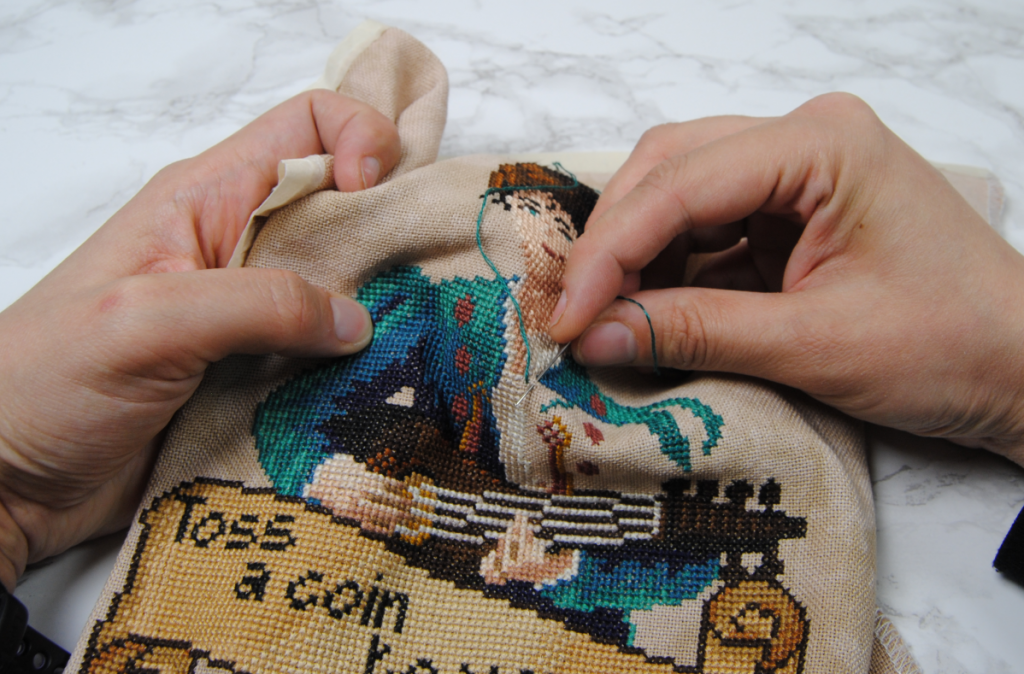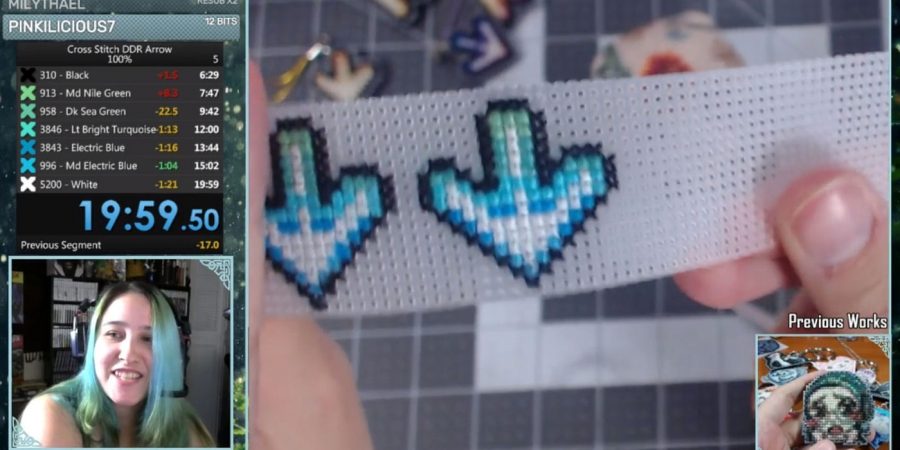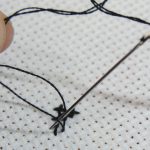This is probably going to be a long post, so let’s start this off by immediately saying this is NOT about whether you are fast or slow. None of that matters. You should not compare yourself to others and/or get upset at yourself for stitching slower due to injury, mental health, multitasking, etc. That’s not the point! Let’s look at a few other scenarios in which knowing your average stitch speed is useful.
- Someone’s Birthday is in 2 weeks and you are looking at patterns you might be able to finish within that time. How many hours a day would you need to work on this to finish it before then?
- Your friend wants to commission you to stitch something for them and asks you how much it would cost. How many hours would it take you so you can quote a decent hourly wage?
- An advertisement from your favorite designer gets posted looking for test stitchers. How many designs could you feasibly finish in a month without burning yourself out?
- You post a WIP of a large project on Instagram and someone asks you how many hours you’ve put into it already. You haven’t really kept track of time, but know you’ve put in about 5k stitches so far.
There are many more scenarios and reasons people would benefit from knowing how fast they stitch. And it doesn’t have to be about being fast or slow. If you are the competitive type, love finding ways to make things more efficient, or just enjoy pushing yourself… it’s OKAY to strive to be faster. Just don’t beat yourself up about it.
If you’re a beginner, getting an idea of your current stitch speed will help you know how much you’ve improved when you test again in a few months. Or a year.
If you’re a long time stitcher, it may help to know if the new stand you bought really did help you get more done.
No matter your skill level, it’s about knowing your limits.

Table of Contents
Choosing the Right Conditions To Test Speed
Regardless of your reasons for figuring out your average speed, it’s important that you test it in actually average conditions.
If you’re just stitching a block of a single color for an hour, it’s naturally going to be faster than something full of color changes and stray confetti stitches.
- Pick an ‘average’ pattern. One with at least a few color changes and no huge blocks of color. If possible, pick a relatively small design you can finish in one sitting, and know the exact stitch count for.
Your fabric and needle can slow you down as well. If you’re not used to 36 count fabric, you’re gonna be taking your time. If you’ve lost your favorite needle and are just breaking in a new one you might find yourself missing the hole more often than normal.
- Use whatever fabric type you lean towards the most, and the needle you use most often.
Similarly if you’re a streamer, sometimes stitch with your kids running around, or are otherwise being interrupted while stitching, you’ll probably stitch slower than you could.
- Stitch in whatever your normal setting is. If you always stitch watching TV, don’t change just for testing.
You want to make sure you’re stitching normally. Don’t pre cut threads just to seem faster. Don’t just toss left over thread if you wouldn’t normally. Whatever habits you have while stitching, stick to them.
- Leave your thread stash as is and know that having to cut new lengths and taking time to wind up leftover thread and put it away is simply part of your process.
Mood and health play a big part in this too. If you’ve had a bad day, chances are you’ll be stitching slower than usual too. It’s important to time yourself a few different times at first to get an actual average. You never know what might be influencing your speed.

How to Keep Track of Time
Don’t over-complicate this. You do not need to keep a stop watch on hand or keep looking at the clock to calculate your time. If anything, constantly checking the time will stress you out and actually make you stitch slower.
Of course, once you’re more comfortable with the process you can definitely set up full speedrun splits and stream it like I did in the screenshot above. But honestly? It’s not necessary. And frankly? It is stressful and even I can’t do more than one or two in a row before I just feel AWFUL. It is by no means my average speed, but more of how fast could I stitch in short bursts. It’s fun to know, but not super helpful when calculating project times.
Instead, try to time your average stitch speed about once a month as part of your normal stitch routine. Or every other month. Speed will fluctuate with moods, how well you slept, etc. So testing again once in a while will help you filter out those variables.
Distracted Stitching
Since I don’t stream anymore, I’m typically listening to an audiobook or podcast. Or watching a show or various YouTube videos. Again, it’s important to test yourself in normal conditions. So do whatever you are normally doing while stitching!
Media is actually a perfect way to time your pieces. If you start a chapter of a book or a movie at the same time as your stitch, you can quickly look at the timestamp when you’ve finished your stitch. Plus the media will distract you from the clock while you work.
If you have to get up to go to the bathroom or go yell at your cat for getting into something, chances are you’re going to pause your book/movie/whatever anyway, so it won’t count against your time!
Are you doing a small stitch just for testing? Then go until you finish and see how far you got in your media during that time. If you’re stitching on your normal project, stitch for one episode of a show and then see how many stitches you did in that time.

Counting Stitches
Okay, no one likes counting that much. So there’s a few different ways to go about this.
- Use a small pattern you know the stitch count to. The DDR arrows I use are a free pattern and have 121 stitches in them.
- If you use Pattern Keeper or similar it counts your stitches FOR you. Neat!
- If you made your own pattern, most pattern programs will output a stitch count for you. (Shown in PC stitch in screenshot above)
- If you’re the type that marks off stitches on a chart as you go… use a different color for this test so you can go back and count how many you did today.
- Most patterns have 10×10 grids marked out. That’s 100 stitches a box. You could pick 2 or more full coverage boxes to focus on and see how long that takes. It’s okay if you go a little outside the box, just add the extras to your stitch count.
Maths
Calculating your average speed
Okay, so as an example I stitched a small design with ~150 stitches and it took me a full episode of She-Ra and 12 minutes into the next one. Now what? Math.
Again, don’t complicate this. Pull out your phone or a calculator or what have you. A full episode of She-Ra is 24 minutes, so I stitched for a total of 36 minutes.
150 stitches divided by 36 minutes is 4.166 stitches a minute. I just left that that crazy long repeating decimal in my calculator and just multiplied 60 minutes to get me to 250 stitches an hour.
This has been my average for the last several years. Soooo, spot on. Sometimes it gets down to ~230, other times it gets up to ~270. But generally I’m around 250. And I’m pretty fast by most people’s standards, so definitely do not beat yourself up if you’re below that. This is just an example.
Estimating how long a project took
Now that I know my average is ~250, if someone asks me how long a design took or how much I’d charge them for a commission, it’s as easy as dividing the total number of stitches in a project by 250.
But how do you know how many stitches are in a project?
- If it’s full coverage, just multiply length times width and you get a nice big number. For example, each one of the squares in my currently abandoned afghan project is 90×90, or 8,100 stitches. Which means they take me on average 32 hours to do.
- Again, if you’re making your own pattern, most pattern programs will output a stitch count for you. Ask around if you’re not sure where to find it.
- Ask the designer. They won’t always have that info on hand, but most are more than happy to provide a stitch count if they have it. That includes me.
- Estimate. Chances are you won’t be doing exactly X number of stitches every hour anyway. It’s okay to just get a rough estimate. Round up when unsure. Better to over-estimate than run out of time.
Regardless, having your average will make it easier to get an idea of how many hours it will take to complete a project. And only you can decide how many hours a day/week you can set aside for stitching, so from there you can get an idea of whether it’s feasible to get this project done in time for Christmas or what-have you.
Improving Your Stitch Speed
Like I said at the very beginning, this should not be about stitching fast or comparing yourself to others. But it can indeed be fun to challenge yourself and have a measure of improvement. So what are some ways to improve your stitch speed?
Practice Makes Perfect
Ok this seems kinda obvious. The more you stitch, and the more comfortable you get with your method, the faster you’ll get.
But there is ultimately a speed cap though, whatever technique you use you’ll eventually reach your top speed. And that’s okay! I’ve been at 250 for years and am comfortable at that rate. But I could improve it, if I change up how I stitch entirely.
Changing Your technique
This is a tricky thing, because changing your technique will actually slow you down while you get used to said new technique. But some techniques ARE considered faster overall and could increase your speed in the long run if you stick with it.
English vs Danish Stitching
In English style stitching you finish an X before moving on to the next. In Danish, you stitch a row of half stitches / / / / , then go back and cross them \ \ \ \.
This is considered to generally be faster, especially when filling in large areas. Partially because once you’ve done the row of half stitches, you don’t need to look at the pattern again to count. You just go back and cross the ones you’ve already done.
Some stitchers even do their entire design in half stitches, and then go back and fill it in without having to look at the pattern ever again! Easily confusing if your colors are very similar, though.
The Sewing Technique
With this technique you won’t use a hoop or Q-snap at all! Basically, you cut out reaching around the back of your project by folding your fabric slightly and getting your needle in position for the next stitch by going straight through the fabric. You can find a simple tutorial for the sewing method here.

Two Handed Stitching
Conversely, this technique requires a hoop/Q-Snap and a stand to hold your work in place while you stitch. It’s tricky to get used to and it’s not feasible for super small projects or things involving plastic canvas, but it can be quite speedy.
Essentially, you have one hand on top aiming the needle, and another below pushing it back up so you don’t have to keep reaching around your project.
Don’t Get Discouraged
I know it’s easier said than done, but it’s normal to feel like you’re going slower than others. But chances are you’re faster than someone else, too.
If anything, feeling discouraged and down on yourself will only make you stitch even slower or get burned out.
At the end of the day, it doesn’t matter how fast you stitched, just that you enjoyed the process of stitching. And hopefully the finished project, too. 😉







